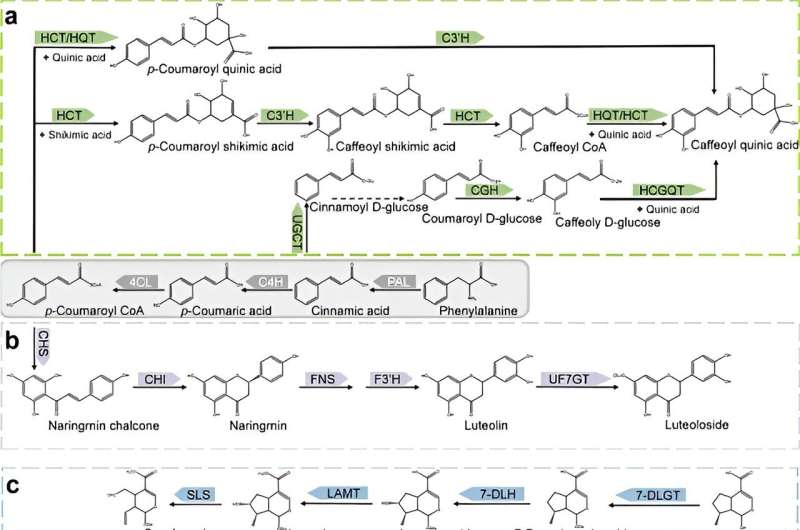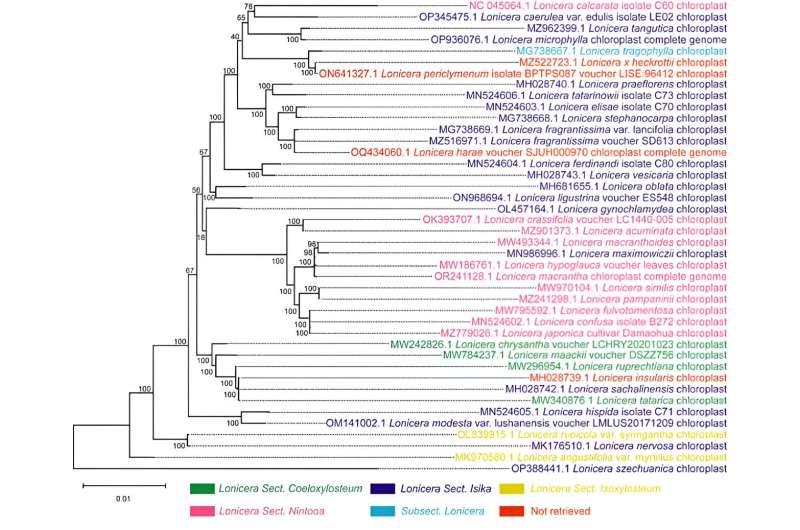Biosynthetic pathways of main bioactive constituents of Lonicera. Credit: Medicinal Plant Biology (2024). DOI: 10.48130/mpb-0024-0008
Lonicera has about 200 species of plants, which have extensive economic benefits and can be used as medicinal materials, food, cosmetics and ornamental plants, etc. As traditional medicinal plants in China, they are used to treat heat related diseases, viral respiratory infections, skin diseases and inflammations. Their bioactive components mainly include chlorogenic acids, flavonoids, iridoids, and triterpene saponins.
Due to the huge demand for Lonicera spp. and the trend of overexploitation of wild resources of Lonicera spp. there is a need for alternative and effective strategies such as metabolic engineering and green production to meet the demand.
A new article in Medicinal Plant Biology provides a comprehensive review of the research progress on the biosynthesis, metabolic engineering structure and pharmacology of the main bioactive components in Lonicera genus.
The article reviews the biosynthesis and metabolic engineering of chlorogenic acid, luteolin, deoxygenated quercetin, and ivy saponin, summarizes the pharmacological research progress of Lonicera plants, and construct a phylogenetic relationship of Lonicera species based on the chloroplast whole genome.
Phylogenetic tree of 42 species of the Lonicera genus based complete chloroplast genome sequence data. Credit: Medicinal Plant Biology (2024). DOI: 10.48130/mpb-0024-0008
In this paper, the biosynthetic pathways and metabolic engineering of the four compounds were first systematically reviewed, providing theoretical references for further improvement of the synthetic biology of the related components.
Existing research results indicate that Lonicera plants have a wide range of pharmacological effects, which are caused by different chemical components.
The article reviews the pharmacological effects of Lonicera plants, including anti-inflammatory, antibacterial, antioxidant stress, and liver protection. In addition, due to the implicit evidence of plant species formation in their genome sequences, molecular level comparative analysis can relatively accurately describe the intrinsic changes that may occur over time.
The article also discusses the subgenus classification of Lonicera plants based on their chloroplast whole genome, providing a theoretical reference for Lonicera plants that have not yet established a clear subgenus classification. At the same time, it is proposed that more species of the Lonicera genus need to be sequenced in order to provide more accurate theoretical basis for the evolution of Lonicera plants and to make more effective revision to the classification of the Lonicera family.
Finally, ways to promote their effective use, including molecular biology tools, were systematically summarized, and suggestions were made for the prospects of fully exploiting the medicinal plant resources of Lonicera.
More information: Xiaojie Chen et al, Research progress on the biosynthesis, metabolic engineering, and pharmacology of bioactive compounds from the Lonicera genus, Medicinal Plant Biology (2024). DOI: 10.48130/mpb-0024-0008
Provided by Chinese Academy of Sciences

























